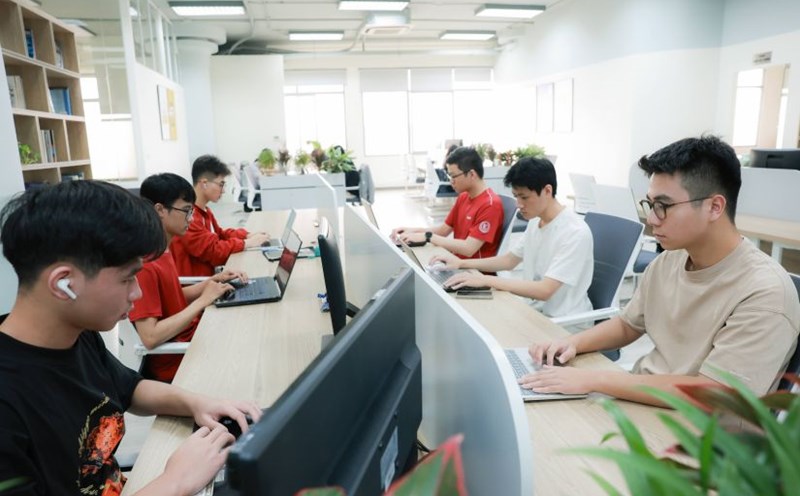Many universities admit students in a hurry
This year's admission season, while many universities have sky-high admission scores, even reaching 30/30 points, a series of other schools have to announce additional admission for hundreds of students. The common admission score is from 15 to 18/30 points; including majors such as medicine, education... causing public concern and questioning the training capacity of many higher education institutions.
"T So many universities are enrolling heavily, some students with only about 15 - 16 points/3 subjects are also invited to join. With such a low input score, can the quality of teaching be guaranteed? Will those students be able to compete in the labor market when they become graduates?" - Ms. Nguyen Thu Huyen - a parent with a child studying in grade 11 in Hanoi - shared.
In fact, this issue has been mentioned many times by experts and according to the planning of the network of higher education and pedagogical institutions for the period 2021-2030 issued by the Ministry of Education and Training, large higher education centers will be formed, about 50 to 60 higher education institutions will be trained to the doctoral level; streamline a number of public higher education institutions; reorganize pedagogical universities in physical education, sports, and arts. Restructure and develop universities into multi-disciplinary and multi-disciplinary higher education institutions with a focus on technology and engineering.
For pedagogical colleges, arrange and organize them in the direction of merging with a pedagogical university or a multi-disciplinary, multi-disciplinary higher education institution (with a school, a department of pedagogical or basic science); Merge with a local or regional higher education institution. Merging and consolidating with a number of other educational institutions in the locality.

The Ministry of Education and Training prepares for the great rearrangement of educational institutions
According to statistics from the Ministry of Education and Training, there are currently 11 universities nationwide; 173 universities and academies (excluding national universities and regional universities), including 61 private universities and 5 foreign universities; 8 training schools with higher education activities; 40 doctoral training research institutes and 5 other institutions with master's and doctoral training. The number of schools in the national defense and security sector is 40.
Regarding this major policy, Minister of Education and Training Nguyen Kim Son said that, except for police, military schools and non-public schools, about 140 public schools scattered in central and local ministries, branches will be rearranged.
The Ministry is considering many options, such as transferring schools under the central government, managed by ministries and branches to localities. Local schools can be merged into Central schools. Or maybe schools under ministries and branches are merged together, many local schools are merged together... Some schools will be dispersed if their scale is too small, not meeting standards...
Associate Professor, Dr. Nguyen Duc Son - Principal of Hanoi National University of Education supports the policy of arranging and merging higher education institutions for the reason " too many universities will distribute resources".
"There are schools with only a few hundred lecturers, which means there are not enough resources to train. This leads to the consequence that a circle without an exit has students to survive, meaning low input, leading to low quality. Such dispersation and disruption do not bring good quality education" - Associate Professor, Dr. Nguyen Duc Son said.
In addition, large-scale units will be able to use common resources including lecturer resources and laboratory resources. He gave an example: Currently, labor houses are expensive, so each school cannot have its own room. But large schools and laboratories used for many industries can immediately do it. Like looking at agriculture, every moment in a place will never become a commodity agriculture.
Suggested arrangement plan
Dr. Le Viet Khuyen - Vice President of the Association of Vietnamese Universities and Colleges - said that the merger of universities is an inevitable trend, however, it is necessary to study carefully, implement carefully, with plan and principles.
Proposing a plan to reorganize and re-plan public universities, Mr. Khuyen said that schools in the same field should not be merged, because it can easily lead to internal competition. Should merge with other schools in the field to form a multi-disciplinary, multi-disciplinary university. In addition, it is necessary to clearly classify elite universities, regional universities and local universities. Each type has its own mission, and cannot be combined mechanistically.
"The feasible solution is to build a clear three-level system: National universities play an elite role; Regional universities serve a large area; Local universities are only responsible for training human resources for provinces and cities.
Ho Chi Minh City and Hanoi can take the lead in applying this classification method, thereby becoming a model for the whole country. If done correctly, these two places will be the place to form a strong, multi-disciplinary, multi-disciplinary university system, with both elite universities leading and local schools that play a good role in training the labor market. On the contrary, if it continues to be segmented and localized, it will fall behind the international trend" - Dr. Le Viet Khuyen emphasized.
He also said that it is necessary to unify management to avoid causing dispersation of resources. To successfully merge, it is necessary to include a focal point, the Ministry of Education and Training. Then, when the school is capable, it will be given real autonomy.
4 notes in the planning and merger of higher education institutions
Associate Professor, Dr. Nguyen Thanh Chuong - Chairman of the Board of the University of Transport - supports the policy of planning and merging higher education institutions. Assessing from the perspective of enrollment, Mr. Chuong said: "It is necessary to assess, which schools are poorly enrolled, stop, which schools are good, good conditions, and need to increase enrollment quotas. This is the law".
Sharing the same view, Dr. Hoang Ngoc Vinh - former Director of the Department of Vocational Education, Ministry of Education and Training - said that the university planning policy is necessary in the context of autonomy in higher education and in the face of changes in socio-economic development strategies.
According to Mr. Vinh, there are some important principles in merging and planning higher education institutions that the Ministry of Education and Training needs to pay attention to.
First, planning must be associated with socio-economic development. It is necessary to analyze the current situation and forecast the demand for highly qualified human resources at the national level, each locality, each economic region, thereby determining the scale of the profession, facilities, land fund and teaching staff.
Second, it is necessary to consider the management capacity of the locality. Resolution 71 of the Politburo requires "respecting the transfer of some universities to local management to improve management efficiency and better meet local human resource training requirements".
However, this process must be carefully considered based on specific criteria and accompanied by a strict monitoring mechanism. Only then can quality be maintained, avoiding decline due to limitation of local resources or negative impacts on university autonomy.
Third, it is necessary to focus on the issue of personnel and organization after the merger. The team of managers and lecturers must be arranged reasonably to create resonance and avoid overlap. At the same time, ineffective training majors and poor enrollment need to be reviewed, streamlined or integrated to focus resources.
Fourth, the merger process needs to ensure the rights and academic quality. The reorganization must be accompanied by a mechanism to protect the rights of students, lecturers and staff to avoid sudden disruption. After the merger, schools must maintain and improve training standards, assessment systems, output standards, considering academic quality as a core factor, avoiding the situation of "toughness but poor quality".
The Ministry of Education and Training will directly manage key universities and colleges
The Ministry of Education and Training (MOET) is soliciting opinions on the draft resolution of the National Assembly on a number of specific mechanisms and policies to implement breakthroughs in education and training development.
The Resolution aims to institutionalize Resolution 71 of the Politburo on breakthroughs in education and training development. The draft resolution is expected to be submitted to the National Assembly at the upcoming 10th session.
In Article 3, the draft resolution states: Continue to arrange and restructure public higher education, vocational education and continuing education institutions (except for educational institutions under the Ministry of Public Security, the Ministry of National Defense, and the Ministry of Foreign Affairs); merge vocational education centers and continuing education centers into vocational secondary schools in inter-ward and commune areas; implement in the direction of reducing focal points, linking professional management responsibilities with personnel and finance, eliminating intermediate levels, ensuring a streamlined, unified and effective management system.
In particular, the Ministry of Education and Training directly manages key universities and colleges or has been planned as a national key university in terms of technology and engineering assigned to lead a network of excellent and talented training centers and colleges performing the function of regional centers, national centers for high-quality vocational training and practice; the Ministry of Health, the Ministry of Culture, Sports and Tourism manage specialized vocational training universities.
Transfer the remaining educational institutions to local management, ensuring full and comprehensive autonomy for educational institutions that do not depend on the level of financial autonomy; Research on merging research institutes with higher education institutions (except for specialized public science and technology organizations).
The wave of university mergers in China and France
The merger of universities has become a trend in many countries in the continents, aiming to increase international competitiveness and overcome limitations in the local education system. In France, the process was initiated in the early 2000s, while in China, three strong lulls of acquisition took place from 1992 to 2000.
In France, Grenoble University was a pioneer in merging with the Grenoble Universites university in 2002, then expanding to many localities. The French Ministry of Education has supported and promoted the formation of University Research and Teaching Organizations (PRES), focusing on enhancing international prestige.
By 2012, 26 PRES were established. Many large universities such as Strasbourg, Aix-Marseille or Lorraine have merged into multi-disciplinary universities, while the associated laboratories help increase research productivity.
In Asia, China began the first wave of university mergers in 1992 in Jiangsu and Guangdong, quickly expanding across the country. During the period of 1993 - 1997, many universities in China merged to improve expertise and reduce problems, such as Jiangxi University or Guizhou. At the peak of 1998 - 2000, a series of institutions merged into leading schools such as Beijing, Jilin, and Hop Phi, with the goal of building world-class universities.
As a result, the number of students, scientific publications, as well as international rankings of universities in China have increased rapidly, most notably Tsinghua University and Beijing, which have risen to the top group in Asia. However, this process also causes difficulties in organizational integration, large reform costs, regional differences and internal tensions after the merger.
The experience of France and China shows that university mergers are an effective tool to expand scale, strengthen cooperation and improve global position, but only promote effectiveness when combined with a long-term governance strategy, reduce conflicts and ensure a balance between teaching, research and social service. Mr. Vu











